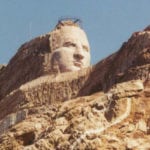 Health
Health  Health
Health  Creepy
Creepy 10 Death Superstitions That Will Give You the Creeps
 Movies and TV
Movies and TV 10 Movies That Get Elite Jobs Right, According to Experts
 Weird Stuff
Weird Stuff 10 Times Real Laws Were Based on Bizarre Hypotheticals
 Animals
Animals 10 Inspiring Tales of Horses Being Human
 Mysteries
Mysteries Top 10 Haunting Facts About the Ghost Ship MV Alta
 History
History 10 Surprising Stories About the Texas Rangers
 Humans
Humans 10 Philosophers Who Were Driven Mad by Their Own Theories
 Miscellaneous
Miscellaneous 10 Video-Game-Worthy Weapons and Armors from History
 Weird Stuff
Weird Stuff 10 Psychics Who Accurately Predicted Wartime Events
 Health
Health Ten Confounding New Inventions from the World of Biomedicine
 Creepy
Creepy 10 Death Superstitions That Will Give You the Creeps
 Movies and TV
Movies and TV 10 Movies That Get Elite Jobs Right, According to Experts
Who's Behind Listverse?

Jamie Frater
Head Editor
Jamie founded Listverse due to an insatiable desire to share fascinating, obscure, and bizarre facts. He has been a guest speaker on numerous national radio and television stations and is a five time published author.
More About Us Weird Stuff
Weird Stuff 10 Times Real Laws Were Based on Bizarre Hypotheticals
 Animals
Animals 10 Inspiring Tales of Horses Being Human
 Mysteries
Mysteries Top 10 Haunting Facts About the Ghost Ship MV Alta
 History
History 10 Surprising Stories About the Texas Rangers
 Humans
Humans 10 Philosophers Who Were Driven Mad by Their Own Theories
 Miscellaneous
Miscellaneous 10 Video-Game-Worthy Weapons and Armors from History
 Weird Stuff
Weird Stuff 10 Psychics Who Accurately Predicted Wartime Events
10 Theorized True Culprits Behind Famous Deadly Attacks
Whether it’s truthers claiming 9/11 was an inside job or Russia trying to finger the West for its own assassinations, political conspiracy theories achieve a special level of crazy. But with so many murky moments in every government’s past, not all of them are quite so crazy. Sometimes, they’re even eerily plausible.
10Algeria’s Secret Service Bombed The Paris Metro

On July 25, 1995, a bomb exploded in a crowded Paris metro car. It was the start of a summer of terror. By October that year, seven more bombs had detonated across France, killing eight and wounding 200. Responsibility was placed on Algeria’s Armed Islamic Group (GIA), seeking revenge for France’s support of their government during the civil war. But there’s another theory: The Algerian government itself was responsible.
In 1991, an Islamist party had swept the first round of elections in Algeria. Fearing a theocracy, the ruling party annulled the elections and allowed the military to seize control. The resulting bloody civil war killed thousands and saw the rise of the GIA. Although the Algerian government was making headway, by 1995, the French government was calling for an end to the violence and the return of democracy. Realizing the only way to keep Paris on its side was to make the GIA a common enemy, according to the theory, the junta had its intelligence services infiltrate the group’s French branch and convince them to bomb Paris in the name of Islam.
Although most dismiss this theory, some evidence supports it. Several of the bombers claimed at their trial that the mastermind, Ali Touchent, was an Algerian spy, and Touchent was allowed to return to Algeria as a free man despite being supposedly wanted there.
9The Romanian Revolution Was Secretly A Coup D’etat

On December 22, 1989, Romania finally reached breaking point. A violent revolution swept dictator Nicolae Ceausescu from power, resulting in his televised execution on Christmas Day. It was the first time a popular uprising in the former USSR had resorted to violence. Many now claim it wasn’t a popular uprising at all.
Ever since Ceausescu bit the bullet, rumors in Romania have said the entire revolution was engineered by self-interested elites. Ion Iliescu, who took control of the transitional government before being elected president in 1990, was formerly a high-ranking Communist who fell out of favor with Ceausescu. The governments he formed were stuffed full of former Communists and members of the Romanian security services, and no one ever faced justice for the dictatorship’s human rights abuses. Meanwhile, the mass privatizations of the 1990s made Iliescu’s Soviet associates rich.
Today, many believe the deaths of 1,000 protesters were less to do with Ceausescu loyalists fighting to save their leader, and more to do with Iliescu creating a smoke screen for seizing power. Just as many, however, believe this is a pointless conspiracy theory.
8Colombia’s Palace Of Justice Siege Was Masterminded By Pablo Escobar

November 6, 1985, marked one of the bloodiest days in Colombia’s long civil war. Armed left-wing group M19 stormed Bogota’s Palace of Justice, taking hundreds of civilians hostage. The military responded by shelling the building, killing the rebels but also accidentally starting a fire that killed nearly 100 hostages.
One school of thought says the fire wasn’t an accident. According to one of his former henchmen, the entire Palace of Justice siege was devised by Pablo Escobar.
At the time, Colombia was considering a new law that would see all narco-traffickers extradited to the United States to stand trial. As the biggest narco-trafficker in town, Escobar had a lot to lose, a fact attested by the mountains of documents in the Palace of Justice implicating him. The theory goes that Escobar convinced the anti-US M19 that their interests aligned in opposing the extradition treaty, paying them $2 million to destroy all the documents relating to his operations. When the army started shelling, M19 set the documents alight, starting the fire that subsequently went out of control.
This theory has a lot of supporters, including people who lost relatives during the siege. However, both M19 and the Colombian government claim there were never any links between Escobar and the rebel group.
7Syria Secretly Funded Al-Qaeda

In the last couple of years, the Syrian civil war has descended into a chaotic mess of warring factions and human rights abuses. While the Assad regime uses chemical weapons on civilians, anti-Assad groups recruit child soldiers and join forces with Al-Qaeda or ISIS. It’s a war with no one to root for, and some think Assad deliberately planned it this way.
In early 2013, Western governments were considering stepping in and siding with the anti-Assad rebels. At the time, the comparatively moderate Free Syrian Army was the leading rebel group, and Assad’s downfall seemed a foregone conclusion. Then Al-Qaeda arrived on the scene. In their wake, they brought division, fear, extremism, and ISIS. Slightly over a year later, the West was again talking about entering Syria, this time in an anti-ISIS alliance with Assad.
Although a grand US-Assad alliance never materialized, many think this was Assad’s strategy all along. By supplying money and arms to the extremist elements of his own opposition, the dictator drowned the moderates out and made his regime look the lesser of two evils. It’s a theory even some diplomats have privately admitted to subscribing to. On the other hand, there’s no doubting that Al-Qaeda and ISIS have made outing Assad their number one priority. Assad himself privately claims the West funded them.
6Gadhafi Deliberately Shot Down A Libyan Plane

Three days before Christmas in 1992, Libyan Arab Airlines Flight 1103 disintegrated 1,000 meters (3,000 ft) above Tripoli airport. All 157 people onboard died. The official line was that a MiG jet collided with the plane. Yet a majority of Libyans now suspect a darker motive. It has been claimed that Gadhafi ordered the plane to be shot down as a way of drawing attention to the negative effect sanctions were having on his country.
Almost exactly four years before Flight 1103 disintegrated, Pan Am Flight 103 had exploded over Scotland, killing 270. Although it’s been suggested that Iran was responsible, the blame was placed firmly on Libya’s intelligence services. As a result, the international community placed firm sanctions on Libya. With the economy hurting, Gadhafi supposedly faked an air crash and blamed the restrictions on Libya receiving airplane parts for the tragedy. The theory goes that he hoped the deaths would galvanize anti-Western sentiment and maybe result in sanctions being lifted.
Although it sounds far-fetched, this theory has a lot of important supporters—not least Gadhafi’s former ambassador to the US, Ali Aujali. Yet with no hard evidence to back it up, a theory is all it currently remains.
5Mexico Arrests Drug Lords For PR

For 13 years, Joaquin Guzman (known as “El Chapo”) was one of the biggest drug lords in the whole of Mexico. A former dealer with a natural flair for smuggling, Guzman grew to become a ruthless killer responsible for many deaths. Then in early 2014, Mexican marines finally captured him in a PR coup for President Enrique Pena Nieto. In fact, the arrest gave Nieto such a boost that many began to believe it had been organized deliberately to improve his international image.
Guzman had already been arrested once, in 1993. He escaped prison in 2001 during a 20-year sentence and had technically been on the run ever since. Yet he seemed to make little effort to hide himself, and many came to the conclusion that he’d bribed the government. So when he was unexpectedly arrested in 2014, they began to wonder what had changed. The answer: Nieto’s poll ratings were beginning to nose-dive.
There was also the timing. Guzman was rearrested just as Obama was due to visit Mexico. Two years previously, the government announced they had almost caught Guzman mere hours before a visit from Hilary Clinton. According to this theory, the Mexican state had known Guzman’s whereabouts for years but waited until a politically convenient time before arresting him.
4The Oklahoma City Bomber Wasn’t Acting Alone

On April 19, 1995, the US experienced what was then the worst terrorist attack in its history. A gigantic fertilizer bomb exploded outside the Alfred P. Murrah Federal Office Building, killing 168 and wounding hundreds. The attack was quickly traced to right-wing extremist Timothy McVeigh and his partner Terry Nichols, whom the FBI determined were working alone. Not everyone agrees.
In the weeks before the blast, 24 separate people saw McVeigh talking with a mysterious man known as John Doe Number 2. After the bombing, John Doe 2 vanished completely and has never been identified. There’s also the date of the bombing. Although most connected it with the Waco Siege from two years earlier, it coincided with the execution of Richard Wayne Snell. A white supremacist who had previously plotted to bomb the Murrah building, Snell had sworn something big would take place on his execution day, claiming there’d be “hell to pay.”
Finally, there’s McVeigh’s involvement with Andreas Strassmeir, a descendant of one of the founding members of the Nazi Party, who ran a far-right compound near Oklahoma City. Exactly two weeks before the bombing, McVeigh made a telephone call to the compound, for reasons still unknown. Many now think McVeigh was acting on orders from either Snell, Strassmeir, or some combination of the two. However, McVeigh’s insisted he was working alone, and the FBI officially considers the case shut.
3The UK Military Is Currently Covering Up Four Trainee Deaths

At 9:30 PM one Saturday night in March 2002, a shot rang out across Deepcut Barracks in Surrey, UK. Private James Collinson, 17, was found dead with a gunshot wound to his head and a rifle in his hands. Four days later, the coroner ruled out suicide. Collinson was the fourth soldier to die at Deepcut in suspicious circumstances in seven years.
In 1995, Cheryl James was found with a bullet wound near her right eye. A few months later, Sean Benton was found dead with five gunshot wounds. The army ruled it suicide despite an independent ballistics expert claiming suicide was physically impossible. Six years later, in 2001, Private Geoff Gray was discovered dead with two gunshot wounds to his head. Again, the army claimed suicide, despite evidence emerging that Gray’s body had been moved after his death.
Although the deaths are still officially considered not suspicious, many people in Britain believe the military and Surrey police colluded to cover something up. Many of the files on the deaths still have not been released, and at the inquest for James’s death, no witnesses were called, and key evidence was not heard. In 2014, Britain’s high court even ordered a new inquest, saying reopening the case was “in the interests of justice.” Depending on their findings, this may be one instance where the conspiracy theory turns out to be true.
2NATO Deliberately Bombed The Chinese Embassy

By May 1999, the Kosovo War was in full swing. NATO was bombing strategic Serbian targets, and Belgrade was in chaos. With no operatives on the ground, the CIA was directing the strikes using old maps and educated guesses. On May 7, this strategy backfired spectacularly. Instead of destroying a Yugoslav arms factory, the agency accidentally had NATO bomb the Chinese Embassy.
The attack killed three Chinese journalists and caused international outcry. Officially, the blame rests on the carelessness of the CIA and NATO stretching their resources too thinly. But there’s another version some believe, including some respected Kosovo war correspondents. NATO bombed the embassy deliberately.
In an article for The Observer, three British, Danish, and American reporters accused NATO of launching an unprovoked attack on China. They claimed NATO’s electronic surveillance unit had detected signals coming from the embassy to Serbian forces, and the Chinese were monitoring US cruise missile attacks as a way of creating countermeasures. In retaliation, the CIA removed the embassy from the “do not bomb” list and fooled NATO into thinking it was an arms factory.
Although official investigations have laughed off this theory, many in China still believe it was a deliberate attack.
1Argentina Allowed Its Own Citizens To Be Bombed By Iran

In July 1994, an explosion ripped through downtown Buenos Aires, killing 85 and injuring hundreds. The target was a Jewish Center, making it the deadliest attack on Jewish civilians since the end of World War II. For years afterward, the Argentinian government dragged its feet in the investigation, until prosecutor Alberto Nisman began to suspect powerful elites were involved.
By January this year, he had collected enough evidence to accuse President Cristina Fernandez of orchestrating one of the worst cover-ups in history. Then, the day before he was due to give evidence to the Argentinian congress, he was found dead with a single gunshot wound to the head. The bullet came from a gun he didn’t own. The official verdict: suicide.
Conspiracy theories quickly started to swirl about Fernandez’s involvement in the bombing. The most popular is that Iran’s intelligence agency was responsible for the blast, and Fernandez brokered a deal to keep silent in exchange for cheap oil. Nisman himself was planning to accuse Fernandez of this just before he died, making many believe there’s some truth to the rumors.
Officially, there’s nothing to see here. Argentina’s Supreme Court dismissed the case on April 21, 2015, and President Fernandez has publicly blamed rogue security elements for Nisman’s death. Yet Argentina has a long history of suspicious suicides tied to authoritarian governments, and over 60 percent of the electorate believe Nisman was murdered. Are they right? We’ll probably never know.








